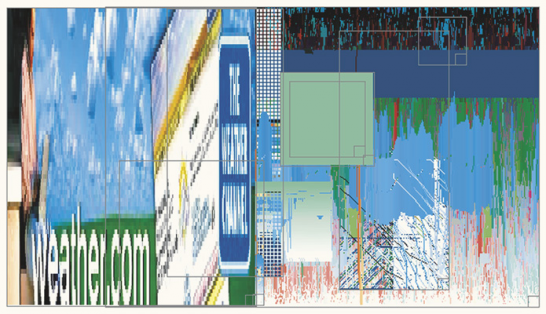| Revista Umělec 2002/3 >> The art of navigation in cyberspace | Lista de todas las ediciones | ||||||||||||
|
|||||||||||||
The art of navigation in cyberspaceRevista Umělec 2002/301.03.2002 Bodil Hovaldt Bojer | media | en cs |
|||||||||||||
|
"“So art [...] apparently exits the real world to re-emerge in the space beyond the screen, the realm of information, a space of shadows, ghosts, dreams and reflections, but also a space of cold data where soft structures turn into hard facts in the real world.”
Jeremy Welsh1 The Internet is American artist and software designer Mark Napier’s medium. The creator of the award-winning website potatoland.org — a conceptual art studio dedicated to exploring the aesthetic and interactive potential of the web — was originally a painter but has worked in the computer industry for many years, designing database software for the financial world. His Internet projects range from his attempt to scan his entire apartment, to distortions of iconic Barbie and digital collages, to interactive networks like his web waste dump, Digital Landfill. Here people dispose of their e-garbage (unwanted e-mails, html, spam) by chucking it into the Digital Landfill where it is composted and recycled for you to paw your way through the virtual compost heap like a scavenger, checking out other people’s garbage. Mark Napier has also created two alternative browsers: Feed 1.0 and Shredder 1.0. Both art pieces function as alternative esthetic browsers with the aim of stepping behind the web in order to show the “invisible” structures and codes hidden behind well-known sites. The art works, which build on and use the net and net myth, appropriate and reorganize websites chosen by the user so they will appear as visual pictures with graphic patterns, colors and text bearing little resemblance to the original websites. Their starting point is the web itself, which they consume and alter, making it a total online experience. Feed and Shredder both consist of websites that in many ways look normal. But instead of showing regular pages, as Explorer or Netscape do, the alternative browsers dissect the web page chosen by the user. As the user activates the artworks by choosing the URL-address, Feed and Shredder begin to read and reinterpret the HTML code hidden behind the visual screen. As the web pages are reduced to unrecognizable patterns of pixels and text, the net familiar to the user transforms into an alternative and parallel network. In many ways the Internet is still treated as a simple publication: Text and pictures are two-dimensional and read one page at a time. But websites are not physical pages; they are temporary graphical images created as browsers interpret html code and instruction. Traditional browsers dictate how the user sees and navigates the structure of the Internet. And as long as all browsers relatively agree on the conventions of the html, the illusion of the net as stable and eternal will continue to dominate. But behind the graphical illusion there is a template of text files, consisting of html code that fill hard drives all over the world. Together these make up the instructions for what we call the Internet. These alternative browsers, contemplative and homogenous rather than commercial and variable, interpret these instructions differently. They promote the visual rather than allowing text to dominate, as it usually does on the web. The anti-browsers function as funnel webs in which an automatic process searches the Internet by reading information from the website and follows the displayed links in loading more codes, thereby continuing the search. This means that in complex sites like Yahoo!, the browsers can continue on infinitely. Danish media scholar and professor Soren Pold describes the browsers as aesthetic tools rather than stable art pieces. Constantly altering as they dissect the Internet, they might just represent a completely new way of aesthetically dealing with Internet dynamics. The first alternative browser, The Web Stalker, was launched in 1997 by the art group I/O/D, since then many others have come down the highway, signifying a need to treat the Internet differently. The anti-browsers comment on our way of working with and digesting information from the Internet, thereby becoming a tool for approaching the Internet from an esthetical-critical perspective. The production of beautiful maps is common to all these browser; useless as a pragmatic approach to the net, they are not meant to show websites as readable content but instead present the user with the possibility of reflecting upon the form and figuration of the Internet and thereby the Internet as concept. Content becomes abstraction, text becomes graphic and information... art. Shredder 1.0 is found at www.potatoland.org/shredder/ where you will also find Digital Landfill and many other works of the artist. Feed 1.0 is found at http://feed.projects.sfmoma.org The Web Stalker can be found at www.backspace.org/iod Notes: 1. From the article “A Yield of Reflections, Shadows, Echoes: Art and the Digital Process,” in: Art and Aesthetics in the 90s — Deterritorializations, 2000 "
01.03.2002
Artículos recomendados
|
|||||||||||||








Comentarios
Actualmente no hay comentariosAgregar nuevo comentario